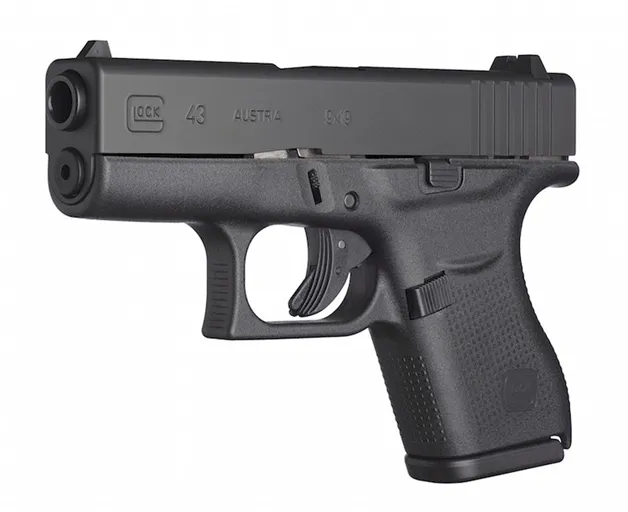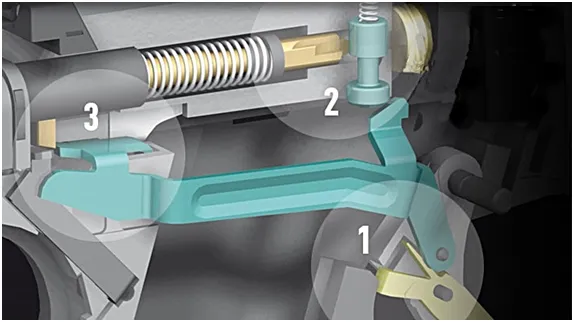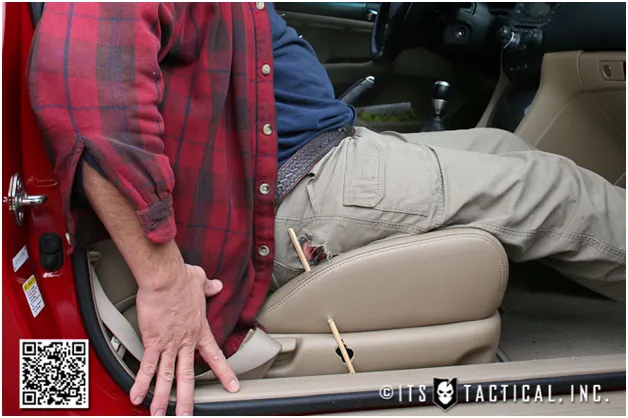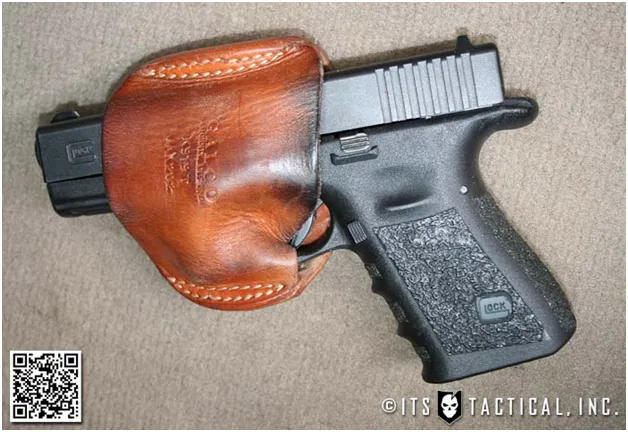Understanding the GLOCK Trigger
By
Wayne Lincourt
GLOCK’s domination of the handgun market is the envy of all of its competitors, yet there’s a controversial element of the GLOCK design: the trigger. So how does the GLOCK trigger really work?

Photo provided by the manufacturer, GLOCK, Inc.
Safe Action Trigger
In designing their trigger system, GLOCK engineers went with as simple a system as possible to reduce parts to an absolute minimum. They incorporated three safeties in the design to protect against accidental discharges, or in the language of the gun community “negligent discharges” (NDs). As you can see from the accompanying schematic, there is a safety lever on the trigger which locks the trigger from moving to the rear unless pressure is applied to the face of the trigger safety to move the blocking arm up and out of the way (1). This is a source of controversy that we’ll discuss in a minute. The second safety is a plunger which blocks the firing pin from moving forward to contact the primer unless the trigger is pulled (2). Finally, a shoe at the rear of the trigger bar rests on a shelf blocking the firing pin from moving until the trigger is pulled (3). This makes the gun highly drop-proof. No matter how the gun lands or the nature of the surface, even on pavement or a hard floor, the firing pin is prevented from moving as long as the trigger isn’t depressed.

Downloaded from https://us.glock.com/technology/safe-action
The end result is a safe modern firearm with a trigger that is always ready to fire without consciously having to move a safety lever to the fire position. The trigger pull is light with a short trigger stroke, and the trigger weight is the same for each shot. It has been found that this trigger system reduces the amount of training time needed to become proficient with the gun, improves accuracy of shot placement, and simplifies the manual of arms. As an added benefit, fewer moving parts means greater reliability.
Law enforcement agencies as well as consumers the world over love the dependability and ease of use that GLOCK represents. This is obvious in the sales numbers and the big share of market that GLOCK enjoys. Still it hasn’t reduced the ongoing controversy over this revolutionary trigger system.
Check out the forums and you’ll see people arguing over whether the GLOCK trigger is single action (SA) or double action only (DAO). They just can’t seem to decide who is right and GLOCK has contributed to the confusion by selling their guns to military and government agencies which required DAO guns. Well you’re about to get the definitive answer.
Is the GLOCK SA or DAO? The correct answer is – NO!
That’s right, it’s neither. GLOCK calls it the Safe Action Trigger but that’s just marketing speak. In actuality, it’s a hybrid. The movement of the slide combined with internal springs partially cocks the firing pin, more accurately called the striker. If it cocked the striker all the way, then it would be a SA because all the trigger would do was release the striker to move forward and strike the firing pin. If the trigger pull cocked the striker all the way before releasing it to fire, then it would be DAO. In reality, the movement of the slide partially cocks the striker and the pull of the trigger completes it, so it’s a little of both.
In practice, the GLOCK functions like a SA pistol. The trigger pull is about 5 ½ pounds with a short stroke and a quick reset. That’s SA territory. Also, you don’t get a second strike capability the way you do with a typical DAO pistol. In other words, because the trigger doesn’t fully cock the action, you can’t just pull the trigger again if the round doesn’t fire on the first try. (Well, you can, but it won’t do anything.)
Is it safe?
Which brings us to our second controversy. Since it has a light trigger and requires just a short stroke to fire, people ask, does it really have a safety. Again, the answer isn’t a simple yes or no. It does have a safety. It’s that little lever sticking out the face of the trigger. However, practically speaking, does it do what you want a safety to do? If you want to prevent the gun from firing should you inadvertently pull the trigger, it doesn’t do that. Some pundits say, “well then don’t pull the trigger until you want to shoot something! Duh.” While that’s good advice, it’s just incomplete (as well as ignorant of the vagaries of life). There have been numerous instances of people being shot without intentionally pulling the trigger. In fact, they didn’t have their finger anywhere near the trigger.

(Downloaded from http://www.itstactical.com/warcom/firearms/safety-warning-worn-leather-holsters-can-cause-accidental-discharges/ )
Take a look at the accompanying photo. This man didn’t pull the trigger. He wasn’t even touching the gun. But he still got shot. Why? Because he was negligent in his choice of holster.

(Downloaded from http://www.itstactical.com/warcom/firearms/safety-warning-worn-leather-holsters-can-cause-accidental-discharges/ )
The leather was soft and when he holstered his gun, it formed a crease which pressed against the face of the trigger. Then when he twisted around to fasten his seat belt, the gun went off.
This is admittedly an unusual case but NDs while holstering are fairly common with GLOCK type triggers. Usually it’s the retention strap on the holster or an article of clothing that gets inside the trigger guard and pulls the trigger. In fact, there’s only one situation for NDs with GLOCKs that’s more common than this: cleaning.
Pull the trigger to disassemble.
To field strip a GLOCK for cleaning, you must pull the trigger before you can remove the slide assembly. The correct procedure, of course, is to remove the magazine and clear the chamber FIRST. Evidently, some people have trouble doing this. And not just inexperienced civilians.

Results of the negligent discharge of a GLOCK. Not a good day. Thanks to the individual who uploaded this photo of himself so others could appreciate what’s at stake. (Downloaded from: https://www.usconcealedcarry.com/two-minute-safety-reminder-glock-safe-action-pistols/ )
In the New York Police Department 2011 report of weapons discharges (https://www.google.com/url?sa=t&rct=j&q=&esrc=s&source=web&cd=1&ved=0ahUKEwiq7Ob0oofLAhWFOyYKHUc6BYUQFggdMAA&url=http%3A%2F%2Fwww.nyc.gov%2Fhtml%2Fnypd%2Fdownloads%2Fpdf%2Fanalysis_and_planning%2Fnypd_annual_firearms_discharge_report_2011.pdf&usg=AFQjCNG0nPs-LF_l-yJhcC5M4KxakjNERg&cad=rjt), there were 13 unintended discharges or NDs. They concluded, “with regard to officers experiencing unintentional discharges while loading or unloading their own firearms, 75 percent of such incidents involved Glocks. Their overrepresentation in this category has been seen consistently over the past five years: since 2007, there have been 31 incidents in which officers unintentionally discharged their own firearms during loading/unloading, and 22 of those incidents—71 percent—have involved Glocks. This most likely stems from the fact that a person disassembling a Glock must depress the trigger to do so.”
NYPD employs a number of different pistols. I don’t know how many are GLOCKs but they were obviously over-represented in NDs indicating a problem. To put things in perspective, there are 35,000 officers in the NYPD so this is not a large amount. About 0.037% or 0.00037 of the total officers. Still, any ND is one too many, especially considering that a number of the NDs resulted in injuries, although fortunately no one died. They concluded the higher than normal number of NDs with GLOCKS “…likely stems from the fact that a person disassembling a Glock must depress the trigger to do so.” I know I already said that but it bears repeating.
Numerous reports indicate a higher than normal number of negligent discharges with GLOCK pistols. These NDs are primarily when holstering a weapon or during disassembly. So does this make GLOCKs dangerous to own and carry? Absolutely not.
How to Prevent Negligent Discharges
Close examination of every ND reveals true negligence on the part of the individual experiencing the ND. I know of no instance where and ND was the result of a failure of any part of a GLOCK. I think my personal experience with a GLOCK is more indicative of the overall cohort of GLOCK owners. I’ve fired thousands of rounds through a GLOCK 19. The bulk of those rounds were during close quarters combat (CQB) training where the gun was drawn and holstered repeatedly. Furthermore, the gun was operated in challenging conditions, with covering garments, while moving and shooting in just about every position you can imagine. Not only did I never have a ND, but I never had a single malfunction. Not one.
The secret to avoiding negligent discharges with a GLOCK is to
- always follow the primary rules of gun handling – never place your finger on the trigger until you’re ready to shoot, never point any gun, loaded or not, at anything you don’t want to destroy, and treat every gun as if it’s loaded – (OK, I know there are 4 rules – “Be sure of your target, what’s in front of it, and what’s behind it” - or 12 or 18 depending on how many lawyers are involved, but for those who aren’t completely brain dead, these will keep you from shooting someone you don’t intend to when routinely handling your gun) --
- always carry in a quality holster, never stick a GLOCK into the waistband of your pants, and never stick a bare GLOCK into a pocket. Some people carry GLOCKs in appropriate holsters in pockets and inside the waistband. I’m not saying that’s wrong but, speaking for myself, I will never carry a GLOCK that way. I also don’t use a holster with a retention strap to carry a GLOCK.
- When holstering, ensure that your garments are well clear of the gun and holster. Toggles and drawstrings on the bottom of jackets have caused NDs. I cut them off. Also holster carefully, never slamming the gun into the holster.
- And always, ALWAYS, clear the chamber after dropping the magazine before you field strip your gun.
I have never had an ND. Please don’t think I’m bragging, I’m not. Yes, I’m very careful to always adhere to the rules of safe gun handling, but, with the number of times and different circumstances in which I’ve handled guns, I have to credit good luck as well. We’re all human and humans are imperfect beings. No one is immune to brain farts. Focus on the three primary rules of safe gun handling so that if you do screw up, you’ll at least not hurt anything but your pride. The NYPD officers who shot themselves in the above example screwed up on more than one of the rules. They failed to clear the chamber and they failed to avoid pointing the gun at something they didn’t want to destroy. Mistakes happen. They always will, no matter how safe we try to make our tools. The two things that will save you when you do make a mistake are 1. Following the three main rules of gun safety, and 2. Training. Although training gets short shrift in gun blogs and magazines, it’s the best way to develop the right muscle memory so that you’re as safe as you can be, even if your brain isn’t firing on all cylinders.
The Verdict
So now you know how the outstanding GLOCK trigger works. This trigger system has helped propel GLOCK to the elevated position they enjoy in today’s market. While there are safety related trade-offs, GLOCKS are as safe as the person running the gun. Enjoy all the benefits that this exceptional family of guns deliver while being smart about it. Obey the rules of safe gun handling, use quality holsters, and train hard.
Happy shooting and be safe.